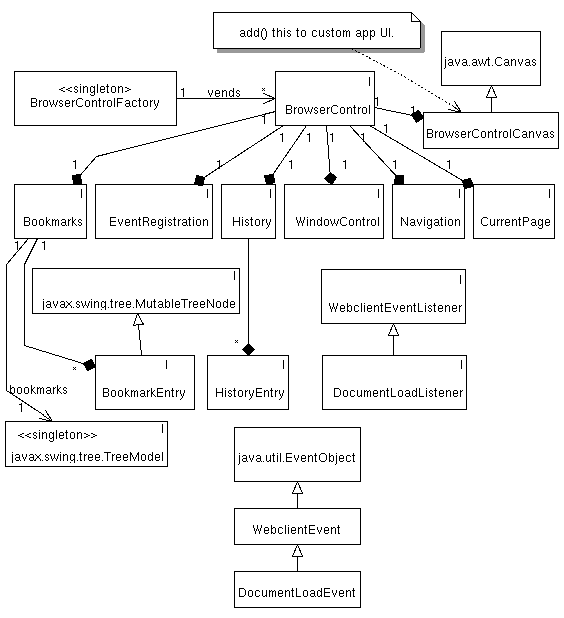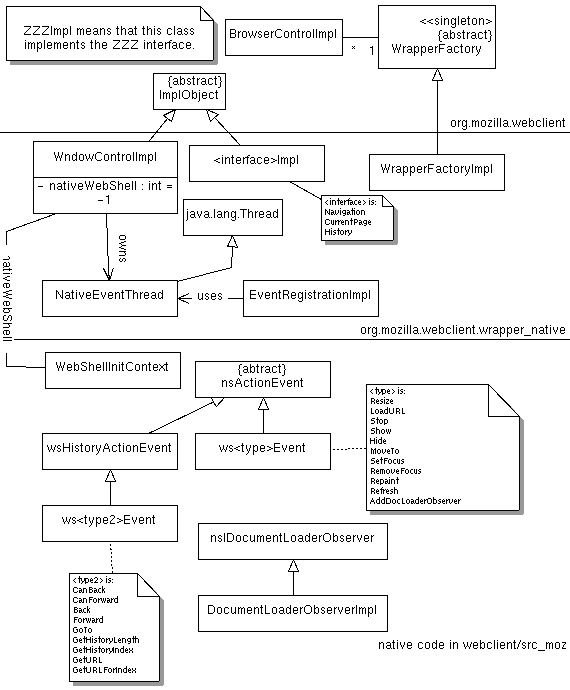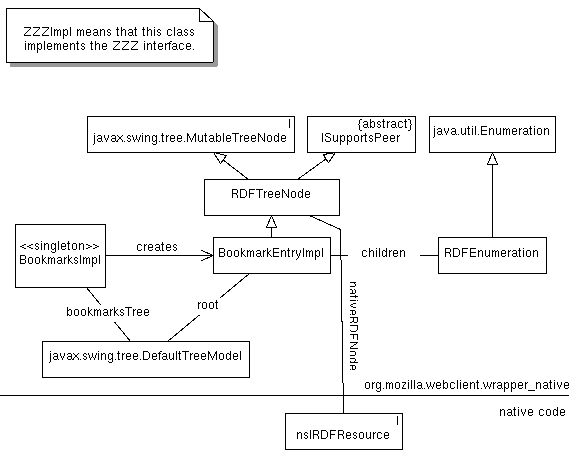
This document is an engineer's overview of the mozilla wrapping implementation of webclient that is compliant with the requirements spec. It is intended as a supplement to the comments in the code. The implementation was written toward version 1.6 of the spec. The term "custom app" is used in this document. The custom app is the third party written application that is using webclient to add browsing capability to its feature set. As of this writing, all of the classes and interfaces mentioned here do exist in the current implementation, but not nearly all of the methods are implemented. Enough is implemented to provide webclient M2 functionality, plus bookmarks viewing, and a DocumentLoadListener event.
This section explains the source code directory structure, and what is
available in each directory. All paths are relative to
mozilla/java/webclient. Directories are examined
depth-first.
This is the root of the java code for the pre-spec-compliant implementation. The code in classes doesn't concern this document.
This is the root of the java code for the spec-compliant implementation. The subdirectory structure of classes_spec mirrors java packages, so code in classes_spec/org/mozilla/webclient is in java package org.mozilla.webclient.
This directory contains the webclient public interfaces, BrowserControlFactory, which is the user's entry point, and a few classes used in sub-packages.
This directory contains the EmbeddedMozilla test browser.
This directory contains the SwingEmbeddedMozilla test browser. This code hasn't been reved to use the spec-compliant implementation.
This directory contains the java code for wrapping a native browser. There is no browser specific java code in webclient. All browser specific code for wrapping native browsers is contained in the JNI implementation code. This directory contains java classes that define native methods which must be implemented by the browser provider. For example, the code in classes_spec/org/mozilla/webclient/src_moz provides an implementation for these native methods.
This directory contains java code for wrapping a native browser on X.
This directory contains java code for wrapping a native browser on win32.
This directory will contain code for wrapping a java based web browser.
This is the root of the native code for the pre-spec-compliant implementation. The code in src doesn't concern this document.
The code for the IE implementation of the JNI interfaces in classes_spec/org/mozilla/webclient/wrapper_native will be kept here.
The code for the Mozilla implementation of the JNI interfaces in classes_spec/org/mozilla/webclient/wrapper_native is kept here.
The unix specific code for the Mozilla implemenation of the JNI interfaces is here.
This section covers the interface and implementation object hierarchies.
The following UML diagram shows the interfaces and classes comprising the current implementation and the relationships among them. Other interfaces and classes defined in the spec, but not yet implemented will be filled in as appropriate.

There is one BrowserControlFactory instance per webclient application. This instance is used to create BrowserControl instances. There is one BrowserControl instance per browser window. Each BrowserControl instance is composed of several constituent interfaces. Instances of these interfaces can be obtained by doing queryInterface() on the BrowserControl instance, passing in the appropriate string, of the form "webclient.BrowserControlCanvas", "webclient.CurrentPage", etc.
The custom app add()'s the BrowserControlCanvas instance to its window hierarchy. The custom app can be notified of webclient events by implementing a WebclientEventListener subinterface and adding that implementation using the EventRegistration interface. The custom-app-defined listener will then receive WebclientEvent instances of the appropriate type at the appropriate time. The custom app can display the browser's bookmarks in a JTree using the Bookmarks interface.
For descriptions of all the clases, please consult the spec.
The following UML diagram shows the primary private classes that comprise the java wrapper for the native implementation. Bookmarks and other secondary classes are dealt with separately. Please note that the classes BrowserControlImpl, ImplObject, and WrapperFactory are in the org.mozilla.webclient java package, while all the other classes are in the org.mozilla.webcllient.wrapper_native package. In general, when one implementation class interacts with another, the interaction is done through the public interface. That is, webclient classes don't have access to other webclient classes's implementation details.

WrapperFactoryImpl and BrowserControlImpl
BrowserControlImpl implements the BrowserControl interface. BrowserControlImpl uses a concrete subclass of WrapperFactory, WrapperFactoryImpl, to create instances of implementations of webclient interfaces. The concrete WrapperFactory subclass is provided by the wrapper_native package. See classes_spec/org/mozilla/webclient/WrapperFactory.java for details. WrapperFactoryImpl calls the first native method, nativeInitialize. See classes_spec/org/mozilla/webclient/wrapper_native/WrapperFactoryImpl.java#nativeInitialize() for details, but briefly, nativeInitialize() does the per-application (as opposed to per-window) browser initialization.
BrowserControlCanvas
The user must send queryInterface() to the BrowserControl instance to obtain implementations of webclient interfaces. The first interface asked for must be "webclient.BrowserControlCanvas". PENDING(): is this requirement a problem? The user must then add() the canvas to its window hierarchy.
ImplObject and WindowControlImpl
Adding the canvas to the display hierarchy causes a WindowControlImpl to be created. This class, as well as all classes implementing webclient interfaces, inherit from ImplObject. ImplObject simply defines the common attributes for all webclient implementation classes. These attributes are currently: the WrapperFactory, and the BrowserControl. See classes_spec/org/mozilla/webclient/ImplObject.java#myFactory for details. The first method of WindowControl called is createWindow(). createWindow() calls the first per-window native call, nativeCreateInitContext(), which allows the native code to create a "context object" that is passed to all subsequent native methods. It then creates and starts a java thread, NativeEventThread, and wait()s. When run, this thread completes the initialization process, sends the WindowControl instance notify(), and goes into an infinite loop. On receiving notify() WindowControl.createWindow() returns. All of this happens on the add() method. PENDING(): is it a problem that the user must add() the BrowserControlCanvas in order for createWindow() to be called, to do per-window initialization?
NavigationImpl, CurrentPageImpl, HistoryImpl
After add()ing the canvas to the custom app display hierarchy, the user may then call BrowserControl.queryInterface() for any other webclient interfaces. The following classes all have similar, straightforward, implementations: NavigationImpl, CurrentPageImpl, HistoryImpl. These classes all use a native event system, explained below in the descriptions for nsActionEvent, and NativeEventThread, to cause the propogation of actions to the underlying browser.
nsActionEvent and subclasses
The webclient native method implementations use an event queue to send actions to the browser. The use of an event queue for sending actions to the browser was present in the initial webclient code obtained from Kirk and Ian. Using the event queue provides synchronization at the native level via mozilla monitors. To examine how these nsActions work, see the comments for the nsActionEvent class definition in nsActions.h. These comments lead you through the source files that touch nsActionEvent subclasses.
NativeEventThread and EventRegistrationImpl
NativeEventThread is a java.lang.Thread subclass. It is created as mentioned in the section on WindowControlImpl. There is one instance of NativeEventThread per BrowserControlImpl. NativeEventThread has two purposes: 1. to process events from the java to the browser. 2. to process events from the browser to java. The details of sending events from java to the browser is described above, in the section on nsActionEvent. The details of sending an event from the browser to java are as follows. When the custom app calls EventRegistration.add*Listener(), the corresponding method in EventRegistrationImpl is called. The different add*Listener methods simply provide type safety. They all call thru to NativeEventThread.addListener(), which ends up adding the corresponding mozilla listener type. See NativeEventThread#addListener(). When a mozilla event occurrs for which the appropriate listener has been added, the native code calls NativeEventThread.nativeEventOccurred(), passing the listener to which the event should be sent, and an event specific long value. nativeEventOccurred() uses java reflection to determine what kind of WebclientEvent should be created and sent to the listener's eventDispatched() method.
WebShellInitContext
There is one instance of this struct per Java WindowControlImpl. This is a context struct used for holding per-window mozilla references. The instance is created as a result of calling WindowControl.createWindow(). PENDING(): it should be destroyed as a result of calling BrowserControl.terminate().
*ObserverImpl
Currently, there is only DocumentLoaderObserverImpl, which serves as the shim between mozilla events and DocumentLoadListener events. See DocumentLoaderObserverImpl.h.
This section deals with private webclient classes that are not part of the core functionality.
The bookmarks interface uses mozilla's RDF bookmarks system to allow the custom app to have acces to mozilla's bookmarks. The following class diagram describes the bookmarks system.

BookmarksImpl
As expected, the custom app obtains a reference to the singleton BookmarksImpl by doing queryInterface on the BrowserControl. Bookmarks provides a way for the custom app developer to show a Swing JTree based UI for the bookmarks. When sent getBookmarks, it calls nativeGetBookmarks(), wraps a BookmarkEntryImpl instance around the returned int, which is actually an nsIRDFResource, and creates a DefaultTreeModel around the new BookmarkEntryImpl.
RDFTreeNode
This abstract base class provides a java wrapper to the mozilla RDF implementation. PENDING(): this only works with RDF graphs that don't have cycles. There is an abstract method, newRDFTreeNode, which is called from several other places in RDFTreeNode.
ISupportsPeer
This abstract class allows RDFTreeNode instances, which have an associated native nsIRDFResource peer, to be properly garbage collected in both Java and XPCOM. It does this by simply providing native methods for XPCOM's AddRef() and Release(). nativeAddRef() can be called from the constructor of a java subclass. This method isn't used since the AddRef()ing comes at the native level. nativeRelease() is called from the java subclass's finalize() method.
BookmarkEntryImpl
This concrete subclass of RDFTreeNode provides a Properties instance into which the bookmarks meta-data is stored. PENDING(): not yet implemented. Instances of BookmarkEntryImpl are created both by the RDFTreeNode's newRDFTreeNode() method, and by Bookmarks.newBookmarkEntry(). The latter method is for when the custom app wants to add a new bookmark. They will call Bookmarks.newBookmarkEntry(), fill in the Properties, and call Bookmarks.addBookmark() with the new bookmark and an option parent BookmarkEntry.
RDFEnumeration
In order to fulfill the TreeNode contract, RDFTreeNode must provide a children() method which returns a java.util.Enumeration of the node's children. This class provides that enumeration. It simply calls through to native RDF methods.